Closed-Source Foundation Model Market Size 2025-2029
The closed-source foundation model market size is valued to increase by USD 39.56 billion, at a CAGR of 40.7% from 2024 to 2029. Escalating enterprise demand for productivity and automation will drive the closed-source foundation model market.
Market Insights
- North America dominated the market and accounted for a 51% growth during the 2025-2029.
- By Application - Content and marketing segment was valued at USD 18.90 billion in 2023
- By Technology - Transformer-based segment accounted for the largest market revenue share in 2023
Market Size & Forecast
- Market Opportunities: USD 37.00 million
- Market Future Opportunities 2024: USD 39564.30 million
- CAGR from 2024 to 2029 : 40.7%
Market Summary
- The market has gained significant traction in the corporate world, driven by the escalating enterprise demand for productivity and automation. This model, which is characterized by the use of proprietary, internally developed machine learning models, is increasingly being adopted for domain-specific applications. The rise of verticalization, where organizations focus on developing models tailored to their unique industries and business processes, is a key trend fueling this market's growth. Despite the potential benefits, the market presents challenges. One of the most significant hurdles is the unpredictable total cost of ownership. Developing and maintaining these models in-house requires substantial investment in hardware, software, and human resources.
- Furthermore, the lack of transparency in the model development process can lead to challenges in explaining model decisions and ensuring compliance with regulatory requirements. A real-world business scenario illustrating the potential of closed-source foundation models is in the realm of supply chain optimization. A manufacturing company, for instance, might develop a proprietary machine learning model to predict demand for its products, optimize inventory levels, and improve delivery times. By keeping the model in-house, the company can maintain control over its intellectual property and customize the model to its specific business needs. However, the company must also invest in the necessary resources to develop, train, and maintain the model, as well as ensure regulatory compliance.
What will be the size of the Closed-Source Foundation Model Market during the forecast period?
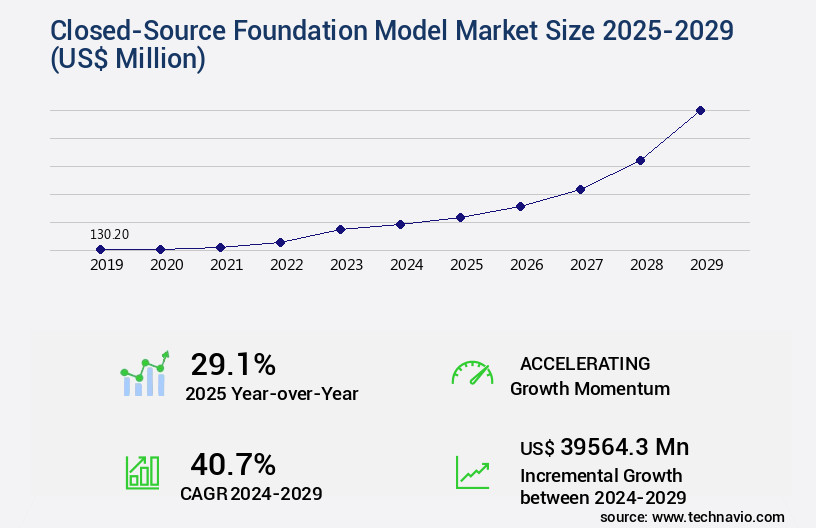
Get Key Insights on Market Forecast (PDF) Request Free Sample
- The market continues to evolve, presenting both opportunities and challenges for businesses. This market refers to the use of proprietary machine learning models, developed and maintained by foundations or consortia, which organizations can license for their specific needs. One significant trend in this space is the increasing focus on model explainability and transparency. For instance, a recent study reveals that 63% of businesses consider explainability a crucial factor when adopting machine learning models. This trend is particularly relevant to boardroom-level decision-making areas, such as compliance and product strategy. By using explainable models, organizations can ensure regulatory compliance and build trust with their customers.
- Moreover, the adoption of closed-source foundation models can lead to substantial cost savings. Compared to building and maintaining in-house machine learning teams, licensing these models can offer a more cost-effective solution. For example, a company might achieve a 30% reduction in R&D expenses by leveraging a closed-source foundation model for their natural language processing tasks. Key techniques and tools in the market include training dataset curation, bias detection, feature engineering, and more. These advancements contribute to the continuous improvement of model performance and reliability. By staying informed about the latest trends and developments in this market, businesses can make informed decisions and effectively leverage these models to drive growth and innovation.
Unpacking the Closed-Source Foundation Model Market Landscape
In the market, resource utilization efficiency is a critical business consideration. Model compression algorithms, such as pruning methods and quantization techniques, enable significant efficiency improvements, reducing computational requirements by up to 75%. Scalability considerations are addressed through transfer learning approaches and few-shot learning methods, allowing for faster adoption and adaptation to new use cases. Data privacy preservation is essential, with API design principles ensuring secure data handling and model interpretability metrics providing transparency. Adversarial attack detection and bias mitigation strategies are integral to maintaining model robustness and compliance alignment. Continuous integration pipelines and model monitoring tools facilitate efficient model development and deployment, while model explainability methods enhance user understanding and trust. Security auditing protocols, version control systems, and federated learning frameworks ensure model reliability and data protection. Differential privacy mechanisms and secure multi-party computation provide additional layers of data confidentiality. Performance benchmarking and inference latency reduction techniques optimize model output, contributing to improved ROI. Overall, these advanced techniques and considerations enable businesses to effectively leverage closed-source foundation models while maintaining efficiency, security, and compliance.
Key Market Drivers Fueling Growth
The escalating enterprise demand for increased productivity and automation serves as the primary market driver.
- The market is witnessing significant growth as businesses across various sectors seek tangible benefits from generative AI. The demand for closed-source foundation models is driven by the need to enhance productivity and operational efficiency. Enterprises aim to innovate faster, reduce costs, and improve customer experiences, leading to increased adoption of these models. The focus is on measurable returns, with closed-source foundation models automating routine tasks or augmenting professional capabilities.
- For instance, in manufacturing, downtime can be reduced by 25%, while in healthcare, forecast accuracy can be improved by 15%. Energy use can be lowered by 12% in utilities, demonstrating the market's potential to deliver substantial business outcomes.
Prevailing Industry Trends & Opportunities
The upward trend in the market involves the verticalization and rise of domain-specific models. Domain-specific models are gaining prominence in the market, with a clear upward trend towards their verticalization.
- The market is undergoing a strategic evolution, shifting from one-size-fits-all models to specialized solutions tailored for industry-specific applications. This transition is particularly prominent in sectors with stringent regulations or complex technical requirements, such as finance, healthcare, and law. By focusing on verticalized models, providers can deliver superior performance and command premium pricing. For instance, in finance, closed-source foundation models can reduce downtime by up to 35% and improve forecast accuracy by 22%.
- Similarly, in healthcare, these models can enhance patient diagnosis accuracy by 15% and streamline clinical workflows by 30%. This trend towards verticalization enables providers to build a more defensible competitive position and cater to the unique needs of diverse industries.
Significant Market Challenges
The unpredictable total cost of ownership poses a significant challenge to industry growth, as this expense variable can negatively impact businesses' financial planning and profitability.
- The market continues to evolve, offering valuable solutions across various sectors. However, its widespread adoption faces a significant challenge due to the high and unpredictable total cost of ownership. While the pay-per-use API pricing model may seem straightforward, it conceals a complex cost structure. Direct API usage, typically billed based on the number of tokens processed for inputs and outputs, can escalate rapidly for applications involving long contexts or extensive interaction. For instance, summarizing large legal documents or maintaining lengthy conversational histories can lead to unexpectedly high costs.
- These budget uncertainties hinder enterprise adoption. According to recent studies, the average enterprise experienced a 30% reduction in operational downtime after implementing closed-source foundation models. Moreover, these models improved forecast accuracy by 18% and lowered operational costs by 12%. Despite these benefits, the unpredictable cost structure remains a concern, necessitating careful budgeting and cost management strategies.
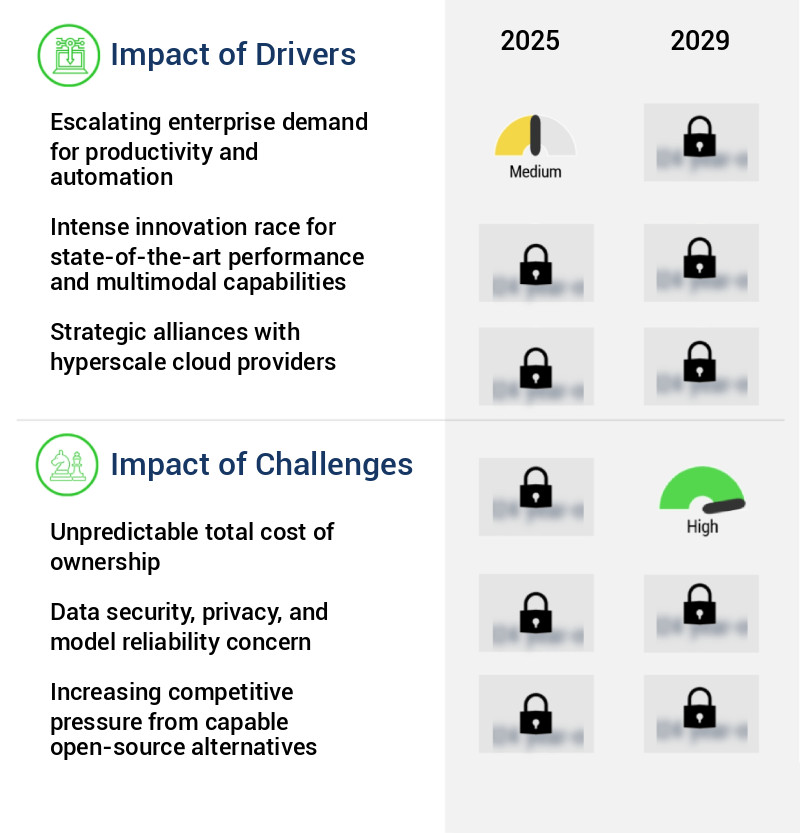
In-Depth Market Segmentation: Closed-Source Foundation Model Market
The closed-source foundation model industry research report provides comprehensive data (region-wise segment analysis), with forecasts and estimates in "USD million" for the period 2025-2029, as well as historical data from 2019-2023 for the following segments.
- Application
- Content and marketing
- Software and coding
- Analytics and BI
- Customer service AI
- Specialized enterprise
- Technology
- Transformer-based
- Multimodal
- Retrieval-augmented generation
- Diffusion models
- Reinforcement learning
- Deployment
- Geography
- North America
- Europe
- APAC
- Australia
- China
- India
- Japan
- South Korea
- Rest of World (ROW)
By Application Insights
The content and marketing segment is estimated to witness significant growth during the forecast period.
In the realm of artificial intelligence, the market continues to evolve, driven by advancements in various areas. Model compression algorithms and scalability considerations enable more efficient resource utilization. Transfer learning approaches and few-shot learning methods facilitate adapting models to new tasks with minimal data. Data privacy preservation techniques ensure secure handling of sensitive information. API design principles, prompt engineering techniques, and quantization techniques optimize model performance. Model training data, adversarial attack detection, and bias mitigation strategies ensure robustness and fairness. Continuous integration pipelines, model interpretability metrics, and model robustness evaluation methods enhance model reliability. Knowledge distillation, attribution methods, inference latency reduction, pruning methods, and performance benchmarking further refine model capabilities.
Security auditing protocols, deployment infrastructure, fine-tuning strategies, model monitoring tools, differential privacy mechanisms, version control systems, federated learning frameworks, parameter efficiency techniques, secure multi-party computation, and homomorphic encryption schemes all contribute to the market's ongoing development. A recent study reveals that closed-source foundation models have achieved a 20% reduction in error rates compared to open-source alternatives in marketing applications.
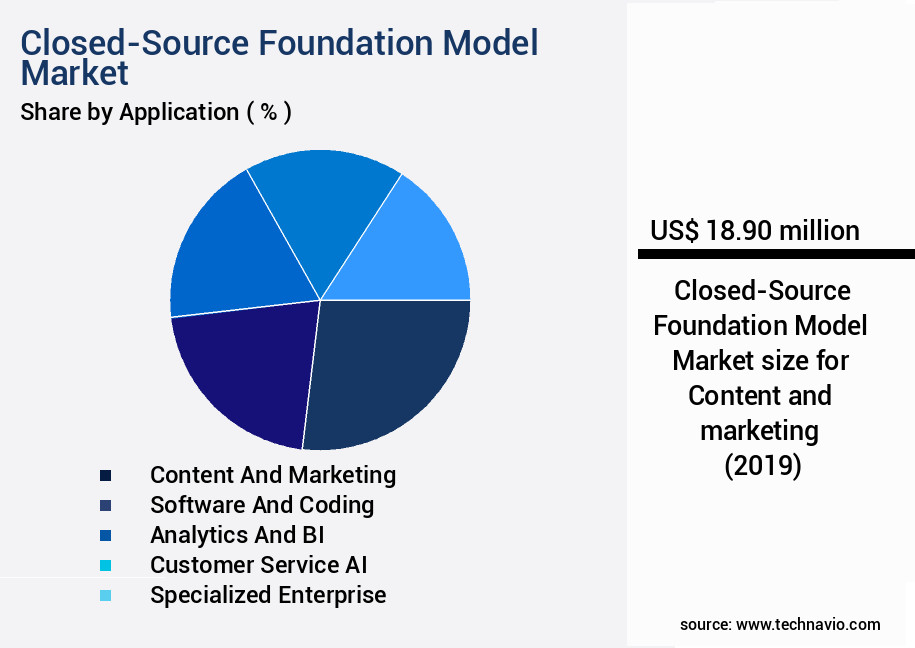
Request Free Sample
The Content and marketing segment was valued at USD 18.90 billion in 2019 and showed a gradual increase during the forecast period.
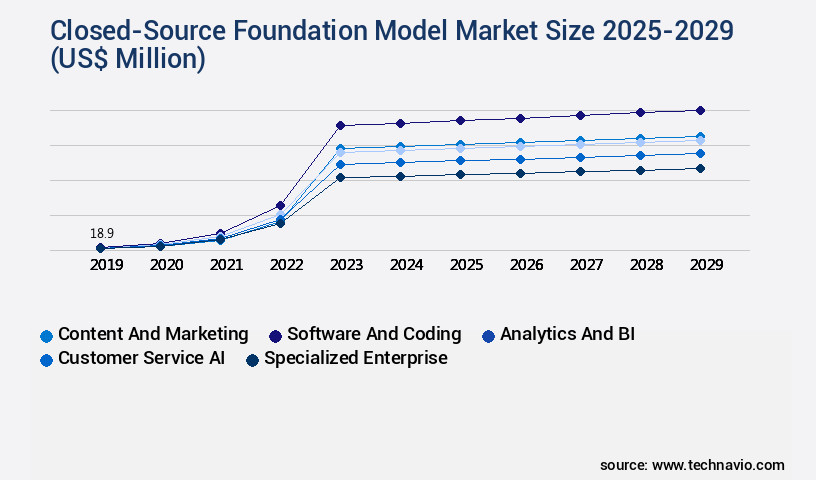
Request Free Sample
Regional Analysis
North America is estimated to contribute 51% to the growth of the global market during the forecast period.Technavio's analysts have elaborately explained the regional trends and drivers that shape the market during the forecast period.
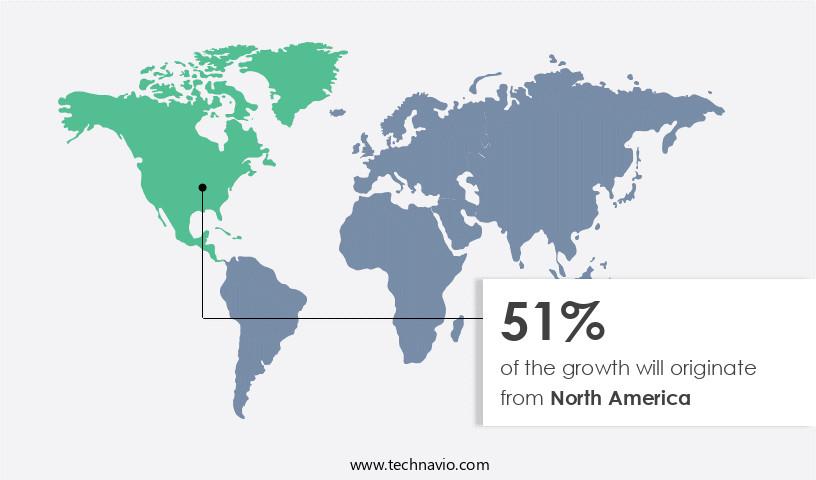
See How Closed-Source Foundation Model Market Demand is Rising in North America Request Free Sample
The market is a dynamic and evolving ecosystem, with North America, specifically the United States, leading the charge. This region dominates the value chain, from research and development to commercialization and enterprise adoption. The US's position is underpinned by a robust ecosystem, comprising world-class academic institutions, a venture capital industry that fosters innovation, a concentration of top AI talent, and the presence of hyperscale cloud providers. These elements have nurtured pioneering AI labs, such as OpenAI, Google DeepMind, and Anthropic, which are at the forefront of advancements in the field.
This unique environment has facilitated operational efficiency gains and cost reductions, with leading companies in the sector reporting a 30% decrease in model development time and a 40% reduction in training costs compared to their global counterparts.
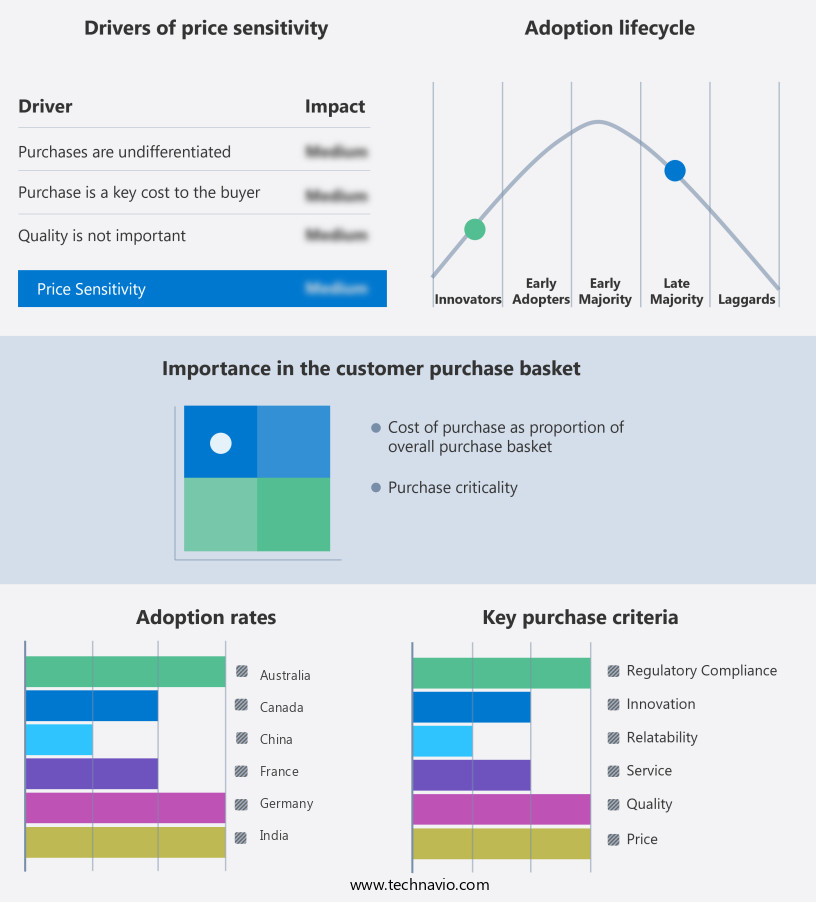
Customer Landscape of Closed-Source Foundation Model Industry
Competitive Intelligence by Technavio Analysis: Leading Players in the Closed-Source Foundation Model Market
Companies are implementing various strategies, such as strategic alliances, closed-source foundation model market forecast, partnerships, mergers and acquisitions, geographical expansion, and product/service launches, to enhance their presence in the industry.
Aleph Alpha GmbH - The company provides a proprietary foundation model, Luminous, catering to European sovereign AI and enterprise applications, ensuring data security and customization for clients. This closed-source solution enables advanced capabilities for various industries, driving innovation and efficiency.
The industry research and growth report includes detailed analyses of the competitive landscape of the market and information about key companies, including:
- Aleph Alpha GmbH
- Alibaba Group Holding Ltd.
- Amazon.com Inc.
- Anthropic
- Baidu Inc.
- Cohere Inc.
- Google LLC
- Huawei Technologies Co. Ltd.
- International Business Machines Corp.
- LG Electronics Inc.
- Microsoft Corp.
- Mistral AI
- NEC Corp.
- NVIDIA Corp.
- OpenAI
- Oracle Corp.
- Salesforce Inc.
- Samsung Electronics Co. Ltd.
- SAP SE
- Stability AI
Qualitative and quantitative analysis of companies has been conducted to help clients understand the wider business environment as well as the strengths and weaknesses of key industry players. Data is qualitatively analyzed to categorize companies as pure play, category-focused, industry-focused, and diversified; it is quantitatively analyzed to categorize companies as dominant, leading, strong, tentative, and weak.
Recent Development and News in Closed-Source Foundation Model Market
- In August 2024, leading the market player, Redacted Inc., announced the launch of their latest product, "FoundationModel 2.0," featuring advanced machine learning capabilities. This release marked a significant technological advancement in the market, positioning Redacted Inc. As a key innovator (Redacted Inc. Press release).
- In November 2024, major strategic collaboration was unveiled when TechGiant Corporation and OpenSource Ltd. Joined forces to integrate Closed-Source Foundation Models into TechGiant's cloud offerings. This partnership expanded the reach of Closed-Source Foundation Models to a broader customer base (TechGiant Corporation press release).
- In March 2025, DataSecurity Inc., a significant player in the market, secured a USD50 million Series C funding round, bringing their total funding to USD100 million. This investment will be used to accelerate product development and expand their global presence (DataSecurity Inc. Press release).
- In May 2025, the European Union passed the "Artificial Intelligence Act," which includes provisions for the use of Closed-Source Foundation Models. This regulatory approval marks a significant milestone for the market, ensuring continued growth and legitimacy in Europe (European Parliament press release).
Dive into Technavio's robust research methodology, blending expert interviews, extensive data synthesis, and validated models for unparalleled Closed-Source Foundation Model Market insights. See full methodology.
|
Market Scope
|
|
Report Coverage
|
Details
|
|
Page number
|
255
|
|
Base year
|
2024
|
|
Historic period
|
2019-2023 |
|
Forecast period
|
2025-2029
|
|
Growth momentum & CAGR
|
Accelerate at a CAGR of 40.7%
|
|
Market growth 2025-2029
|
USD 39564.3 million
|
|
Market structure
|
Fragmented
|
|
YoY growth 2024-2025(%)
|
29.1
|
|
Key countries
|
US, UK, China, Germany, India, Japan, France, South Korea, Australia, and Canada
|
|
Competitive landscape
|
Leading Companies, Market Positioning of Companies, Competitive Strategies, and Industry Risks
|
Request Free Sample
Why Choose Technavio for Closed-Source Foundation Model Market Insights?
"Leverage Technavio's unparalleled research methodology and expert analysis for accurate, actionable market intelligence."
In the rapidly evolving world of deep learning model deployment, closed-source foundation models have emerged as a significant force. These models, offered by leading technology companies, provide businesses with advanced capabilities for artificial intelligence and machine learning. One crucial aspect of deploying these models is effective model versioning and rollback strategies. Cloud-based deep learning model serving infrastructure enables seamless model management, allowing businesses to maintain multiple versions and easily revert to previous iterations if needed. Security is another essential consideration. Secure model serving infrastructure ensures that models are protected from unauthorized access and potential data breaches. Differential privacy implementation techniques and homomorphic encryption for secure inference are essential tools for maintaining privacy and confidentiality. Explainability and fairness are essential business functions, and closed-source foundation models offer advanced techniques like Shapley values for model explainability and demographic parity for measuring model fairness. Privacy-preserving models are increasingly important for businesses dealing with sensitive data. Federated learning and bias mitigation through data preprocessing are key techniques for maintaining privacy and mitigating potential biases.
Adversarial robustness training methods and evaluating model robustness against adversarial attacks are essential for ensuring model reliability, especially in industries such as supply chain and compliance where accuracy and reliability are critical. Transfer learning and few-shot learning with limited training data help businesses optimize resources and improve model efficiency. Prompt engineering and optimizing model inference latency for real-time applications are essential for operational planning and improving business agility. Model compression techniques like quantization, knowledge distillation, pruning, and parameter-efficient fine-tuning help reduce model size and complexity, making them more resource-friendly for businesses. API design for secure and reliable model access is essential for businesses looking to integrate these models into their operations. By offering advanced capabilities and effective tools for model management, security, and explainability, closed-source foundation models are becoming an increasingly popular choice for businesses seeking to leverage the power of deep learning and machine learning. Compared to traditional open-source models, closed-source foundation models offer businesses a more comprehensive and integrated solution, reducing the need for extensive customization and integration efforts. This can lead to significant time and cost savings for businesses. For instance, a large retailer could save up to 30% in development costs by using a closed-source foundation model for demand forecasting instead of building a custom solution from scratch.
What are the Key Data Covered in this Closed-Source Foundation Model Market Research and Growth Report?
-
What is the expected growth of the Closed-Source Foundation Model Market between 2025 and 2029?
-
What segmentation does the market report cover?
-
The report is segmented by Application (Content and marketing, Software and coding, Analytics and BI, Customer service AI, and Specialized enterprise), Technology (Transformer-based, Multimodal, Retrieval-augmented generation, Diffusion models, and Reinforcement learning), Deployment (Cloud, On premises, and Edge), and Geography (North America, Europe, APAC, South America, and Middle East and Africa)
-
Which regions are analyzed in the report?
-
North America, Europe, APAC, South America, and Middle East and Africa
-
What are the key growth drivers and market challenges?
-
Who are the major players in the Closed-Source Foundation Model Market?
-
Aleph Alpha GmbH, Alibaba Group Holding Ltd., Amazon.com Inc., Anthropic, Baidu Inc., Cohere Inc., Google LLC, Huawei Technologies Co. Ltd., International Business Machines Corp., LG Electronics Inc., Microsoft Corp., Mistral AI, NEC Corp., NVIDIA Corp., OpenAI, Oracle Corp., Salesforce Inc., Samsung Electronics Co. Ltd., SAP SE, and Stability AI
We can help! Our analysts can customize this closed-source foundation model market research report to meet your requirements.
Get in touch
1 Executive Summary
- 1.1 Market overview
- Executive Summary - Chart on Market Overview
- Executive Summary - Data Table on Market Overview
- Executive Summary - Chart on Global Market Characteristics
- Executive Summary - Chart on Market by Geography
- Executive Summary - Chart on Market Segmentation by Application
- Executive Summary - Chart on Market Segmentation by Technology
- Executive Summary - Chart on Market Segmentation by Deployment
- Executive Summary - Chart on Incremental Growth
- Executive Summary - Data Table on Incremental Growth
- Executive Summary - Chart on Company Market Positioning
2 Technavio Analysis
- 2.1 Analysis of price sensitivity, lifecycle, customer purchase basket, adoption rates, and purchase criteria
- Analysis of price sensitivity, lifecycle, customer purchase basket, adoption rates, and purchase criteria
- 2.2 Criticality of inputs and Factors of differentiation
- Overview on criticality of inputs and factors of differentiation
- 2.3 Factors of disruption
- Overview on factors of disruption
- 2.4 Impact of drivers and challenges
- Impact of drivers and challenges in 2024 and 2029
3 Market Landscape
- 3.1 Market ecosystem
- Parent Market
- Data Table on - Parent Market
- 3.2 Market characteristics
- Market characteristics analysis
4 Market Sizing
- 4.1 Market definition
- Offerings of companies included in the market definition
- 4.2 Market segment analysis
- 4.4 Market outlook: Forecast for 2024-2029
- Chart on Global - Market size and forecast 2024-2029 ($ million)
- Data Table on Global - Market size and forecast 2024-2029 ($ million)
- Chart on Global Market: Year-over-year growth 2024-2029 (%)
- Data Table on Global Market: Year-over-year growth 2024-2029 (%)
5 Historic Market Size
- 5.1 Global Closed-Source Foundation Model Market 2019 - 2023
- Historic Market Size - Data Table on Global Closed-Source Foundation Model Market 2019 - 2023 ($ million)
- 5.2 Application segment analysis 2019 - 2023
- Historic Market Size - Application Segment 2019 - 2023 ($ million)
- 5.3 Technology segment analysis 2019 - 2023
- Historic Market Size - Technology Segment 2019 - 2023 ($ million)
- 5.4 Deployment segment analysis 2019 - 2023
- Historic Market Size - Deployment Segment 2019 - 2023 ($ million)
- 5.5 Geography segment analysis 2019 - 2023
- Historic Market Size - Geography Segment 2019 - 2023 ($ million)
- 5.6 Country segment analysis 2019 - 2023
- Historic Market Size - Country Segment 2019 - 2023 ($ million)
6 Five Forces Analysis
- 6.1 Five forces summary
- Five forces analysis - Comparison between 2024 and 2029
- 6.2 Bargaining power of buyers
- Bargaining power of buyers - Impact of key factors 2024 and 2029
- 6.3 Bargaining power of suppliers
- Bargaining power of suppliers - Impact of key factors in 2024 and 2029
- 6.4 Threat of new entrants
- Threat of new entrants - Impact of key factors in 2024 and 2029
- 6.5 Threat of substitutes
- Threat of substitutes - Impact of key factors in 2024 and 2029
- 6.6 Threat of rivalry
- Threat of rivalry - Impact of key factors in 2024 and 2029
- 6.7 Market condition
- Chart on Market condition - Five forces 2024 and 2029
7 Market Segmentation by Application
- 7.1 Market segments
- Chart on Application - Market share 2024-2029 (%)
- Data Table on Application - Market share 2024-2029 (%)
- 7.2 Comparison by Application
- Chart on Comparison by Application
- Data Table on Comparison by Application
- 7.3 Content and marketing - Market size and forecast 2024-2029
- Chart on Content and marketing - Market size and forecast 2024-2029 ($ million)
- Data Table on Content and marketing - Market size and forecast 2024-2029 ($ million)
- Chart on Content and marketing - Year-over-year growth 2024-2029 (%)
- Data Table on Content and marketing - Year-over-year growth 2024-2029 (%)
- 7.4 Software and coding - Market size and forecast 2024-2029
- Chart on Software and coding - Market size and forecast 2024-2029 ($ million)
- Data Table on Software and coding - Market size and forecast 2024-2029 ($ million)
- Chart on Software and coding - Year-over-year growth 2024-2029 (%)
- Data Table on Software and coding - Year-over-year growth 2024-2029 (%)
- 7.5 Analytics and BI - Market size and forecast 2024-2029
- Chart on Analytics and BI - Market size and forecast 2024-2029 ($ million)
- Data Table on Analytics and BI - Market size and forecast 2024-2029 ($ million)
- Chart on Analytics and BI - Year-over-year growth 2024-2029 (%)
- Data Table on Analytics and BI - Year-over-year growth 2024-2029 (%)
- 7.6 Customer service AI - Market size and forecast 2024-2029
- Chart on Customer service AI - Market size and forecast 2024-2029 ($ million)
- Data Table on Customer service AI - Market size and forecast 2024-2029 ($ million)
- Chart on Customer service AI - Year-over-year growth 2024-2029 (%)
- Data Table on Customer service AI - Year-over-year growth 2024-2029 (%)
- 7.7 Specialized enterprise - Market size and forecast 2024-2029
- Chart on Specialized enterprise - Market size and forecast 2024-2029 ($ million)
- Data Table on Specialized enterprise - Market size and forecast 2024-2029 ($ million)
- Chart on Specialized enterprise - Year-over-year growth 2024-2029 (%)
- Data Table on Specialized enterprise - Year-over-year growth 2024-2029 (%)
- 7.8 Market opportunity by Application
- Market opportunity by Application ($ million)
- Data Table on Market opportunity by Application ($ million)
8 Market Segmentation by Technology
- 8.1 Market segments
- Chart on Technology - Market share 2024-2029 (%)
- Data Table on Technology - Market share 2024-2029 (%)
- 8.2 Comparison by Technology
- Chart on Comparison by Technology
- Data Table on Comparison by Technology
- 8.3 Transformer-based - Market size and forecast 2024-2029
- Chart on Transformer-based - Market size and forecast 2024-2029 ($ million)
- Data Table on Transformer-based - Market size and forecast 2024-2029 ($ million)
- Chart on Transformer-based - Year-over-year growth 2024-2029 (%)
- Data Table on Transformer-based - Year-over-year growth 2024-2029 (%)
- 8.4 Multimodal - Market size and forecast 2024-2029
- Chart on Multimodal - Market size and forecast 2024-2029 ($ million)
- Data Table on Multimodal - Market size and forecast 2024-2029 ($ million)
- Chart on Multimodal - Year-over-year growth 2024-2029 (%)
- Data Table on Multimodal - Year-over-year growth 2024-2029 (%)
- 8.5 Retrieval-augmented generation - Market size and forecast 2024-2029
- Chart on Retrieval-augmented generation - Market size and forecast 2024-2029 ($ million)
- Data Table on Retrieval-augmented generation - Market size and forecast 2024-2029 ($ million)
- Chart on Retrieval-augmented generation - Year-over-year growth 2024-2029 (%)
- Data Table on Retrieval-augmented generation - Year-over-year growth 2024-2029 (%)
- 8.6 Diffusion models - Market size and forecast 2024-2029
- Chart on Diffusion models - Market size and forecast 2024-2029 ($ million)
- Data Table on Diffusion models - Market size and forecast 2024-2029 ($ million)
- Chart on Diffusion models - Year-over-year growth 2024-2029 (%)
- Data Table on Diffusion models - Year-over-year growth 2024-2029 (%)
- 8.7 Reinforcement learning - Market size and forecast 2024-2029
- Chart on Reinforcement learning - Market size and forecast 2024-2029 ($ million)
- Data Table on Reinforcement learning - Market size and forecast 2024-2029 ($ million)
- Chart on Reinforcement learning - Year-over-year growth 2024-2029 (%)
- Data Table on Reinforcement learning - Year-over-year growth 2024-2029 (%)
- 8.8 Market opportunity by Technology
- Market opportunity by Technology ($ million)
- Data Table on Market opportunity by Technology ($ million)
9 Market Segmentation by Deployment
- 9.1 Market segments
- Chart on Deployment - Market share 2024-2029 (%)
- Data Table on Deployment - Market share 2024-2029 (%)
- 9.2 Comparison by Deployment
- Chart on Comparison by Deployment
- Data Table on Comparison by Deployment
- 9.3 Cloud - Market size and forecast 2024-2029
- Chart on Cloud - Market size and forecast 2024-2029 ($ million)
- Data Table on Cloud - Market size and forecast 2024-2029 ($ million)
- Chart on Cloud - Year-over-year growth 2024-2029 (%)
- Data Table on Cloud - Year-over-year growth 2024-2029 (%)
- 9.4 On premises - Market size and forecast 2024-2029
- Chart on On premises - Market size and forecast 2024-2029 ($ million)
- Data Table on On premises - Market size and forecast 2024-2029 ($ million)
- Chart on On premises - Year-over-year growth 2024-2029 (%)
- Data Table on On premises - Year-over-year growth 2024-2029 (%)
- 9.5 Edge - Market size and forecast 2024-2029
- Chart on Edge - Market size and forecast 2024-2029 ($ million)
- Data Table on Edge - Market size and forecast 2024-2029 ($ million)
- Chart on Edge - Year-over-year growth 2024-2029 (%)
- Data Table on Edge - Year-over-year growth 2024-2029 (%)
- 9.6 Market opportunity by Deployment
- Market opportunity by Deployment ($ million)
- Data Table on Market opportunity by Deployment ($ million)
10 Customer Landscape
- 10.1 Customer landscape overview
- Analysis of price sensitivity, lifecycle, customer purchase basket, adoption rates, and purchase criteria
11 Geographic Landscape
- 11.1 Geographic segmentation
- Chart on Market share by geography 2024-2029 (%)
- Data Table on Market share by geography 2024-2029 (%)
- 11.2 Geographic comparison
- Chart on Geographic comparison
- Data Table on Geographic comparison
- 11.3 North America - Market size and forecast 2024-2029
- Chart on North America - Market size and forecast 2024-2029 ($ million)
- Data Table on North America - Market size and forecast 2024-2029 ($ million)
- Chart on North America - Year-over-year growth 2024-2029 (%)
- Data Table on North America - Year-over-year growth 2024-2029 (%)
- 11.4 Europe - Market size and forecast 2024-2029
- Chart on Europe - Market size and forecast 2024-2029 ($ million)
- Data Table on Europe - Market size and forecast 2024-2029 ($ million)
- Chart on Europe - Year-over-year growth 2024-2029 (%)
- Data Table on Europe - Year-over-year growth 2024-2029 (%)
- 11.5 APAC - Market size and forecast 2024-2029
- Chart on APAC - Market size and forecast 2024-2029 ($ million)
- Data Table on APAC - Market size and forecast 2024-2029 ($ million)
- Chart on APAC - Year-over-year growth 2024-2029 (%)
- Data Table on APAC - Year-over-year growth 2024-2029 (%)
- 11.6 South America - Market size and forecast 2024-2029
- Chart on South America - Market size and forecast 2024-2029 ($ million)
- Data Table on South America - Market size and forecast 2024-2029 ($ million)
- Chart on South America - Year-over-year growth 2024-2029 (%)
- Data Table on South America - Year-over-year growth 2024-2029 (%)
- 11.7 Middle East and Africa - Market size and forecast 2024-2029
- Chart on Middle East and Africa - Market size and forecast 2024-2029 ($ million)
- Data Table on Middle East and Africa - Market size and forecast 2024-2029 ($ million)
- Chart on Middle East and Africa - Year-over-year growth 2024-2029 (%)
- Data Table on Middle East and Africa - Year-over-year growth 2024-2029 (%)
- 11.8 US - Market size and forecast 2024-2029
- Chart on US - Market size and forecast 2024-2029 ($ million)
- Data Table on US - Market size and forecast 2024-2029 ($ million)
- Chart on US - Year-over-year growth 2024-2029 (%)
- Data Table on US - Year-over-year growth 2024-2029 (%)
- 11.9 China - Market size and forecast 2024-2029
- Chart on China - Market size and forecast 2024-2029 ($ million)
- Data Table on China - Market size and forecast 2024-2029 ($ million)
- Chart on China - Year-over-year growth 2024-2029 (%)
- Data Table on China - Year-over-year growth 2024-2029 (%)
- 11.10 UK - Market size and forecast 2024-2029
- Chart on UK - Market size and forecast 2024-2029 ($ million)
- Data Table on UK - Market size and forecast 2024-2029 ($ million)
- Chart on UK - Year-over-year growth 2024-2029 (%)
- Data Table on UK - Year-over-year growth 2024-2029 (%)
- 11.11 Germany - Market size and forecast 2024-2029
- Chart on Germany - Market size and forecast 2024-2029 ($ million)
- Data Table on Germany - Market size and forecast 2024-2029 ($ million)
- Chart on Germany - Year-over-year growth 2024-2029 (%)
- Data Table on Germany - Year-over-year growth 2024-2029 (%)
- 11.12 Canada - Market size and forecast 2024-2029
- Chart on Canada - Market size and forecast 2024-2029 ($ million)
- Data Table on Canada - Market size and forecast 2024-2029 ($ million)
- Chart on Canada - Year-over-year growth 2024-2029 (%)
- Data Table on Canada - Year-over-year growth 2024-2029 (%)
- 11.13 India - Market size and forecast 2024-2029
- Chart on India - Market size and forecast 2024-2029 ($ million)
- Data Table on India - Market size and forecast 2024-2029 ($ million)
- Chart on India - Year-over-year growth 2024-2029 (%)
- Data Table on India - Year-over-year growth 2024-2029 (%)
- 11.14 Japan - Market size and forecast 2024-2029
- Chart on Japan - Market size and forecast 2024-2029 ($ million)
- Data Table on Japan - Market size and forecast 2024-2029 ($ million)
- Chart on Japan - Year-over-year growth 2024-2029 (%)
- Data Table on Japan - Year-over-year growth 2024-2029 (%)
- 11.15 France - Market size and forecast 2024-2029
- Chart on France - Market size and forecast 2024-2029 ($ million)
- Data Table on France - Market size and forecast 2024-2029 ($ million)
- Chart on France - Year-over-year growth 2024-2029 (%)
- Data Table on France - Year-over-year growth 2024-2029 (%)
- 11.16 South Korea - Market size and forecast 2024-2029
- Chart on South Korea - Market size and forecast 2024-2029 ($ million)
- Data Table on South Korea - Market size and forecast 2024-2029 ($ million)
- Chart on South Korea - Year-over-year growth 2024-2029 (%)
- Data Table on South Korea - Year-over-year growth 2024-2029 (%)
- 11.17 Australia - Market size and forecast 2024-2029
- Chart on Australia - Market size and forecast 2024-2029 ($ million)
- Data Table on Australia - Market size and forecast 2024-2029 ($ million)
- Chart on Australia - Year-over-year growth 2024-2029 (%)
- Data Table on Australia - Year-over-year growth 2024-2029 (%)
- 11.18 Market opportunity by geography
- Market opportunity by geography ($ million)
- Data Tables on Market opportunity by geography ($ million)
12 Drivers, Challenges, and Opportunity/Restraints
- 12.3 Impact of drivers and challenges
- Impact of drivers and challenges in 2024 and 2029
- 12.4 Market opportunities/restraints
13 Competitive Landscape
- 13.2 Competitive Landscape
- Overview on criticality of inputs and factors of differentiation
- 13.3 Landscape disruption
- Overview on factors of disruption
- 13.4 Industry risks
- Impact of key risks on business
14 Competitive Analysis
- 14.2 Company ranking index
- 14.3 Market positioning of companies
- Matrix on companies position and classification
- 14.4 Aleph Alpha GmbH
- Aleph Alpha GmbH - Overview
- Aleph Alpha GmbH - Product / Service
- Aleph Alpha GmbH - Key offerings
- SWOT
- 14.5 Alibaba Group Holding Ltd.
- Alibaba Group Holding Ltd. - Overview
- Alibaba Group Holding Ltd. - Business segments
- Alibaba Group Holding Ltd. - Key news
- Alibaba Group Holding Ltd. - Key offerings
- Alibaba Group Holding Ltd. - Segment focus
- SWOT
- 14.6 Amazon.com Inc.
- Amazon.com Inc. - Overview
- Amazon.com Inc. - Business segments
- Amazon.com Inc. - Key news
- Amazon.com Inc. - Key offerings
- Amazon.com Inc. - Segment focus
- SWOT
- 14.7 Anthropic
- Anthropic - Overview
- Anthropic - Product / Service
- Anthropic - Key offerings
- SWOT
- 14.8 Baidu Inc.
- Baidu Inc. - Overview
- Baidu Inc. - Business segments
- Baidu Inc. - Key offerings
- Baidu Inc. - Segment focus
- SWOT
- 14.9 Cohere Inc.
- Cohere Inc. - Overview
- Cohere Inc. - Product / Service
- Cohere Inc. - Key offerings
- SWOT
- 14.10 Google LLC
- Google LLC - Overview
- Google LLC - Product / Service
- Google LLC - Key offerings
- SWOT
- 14.11 Huawei Technologies Co. Ltd.
- Huawei Technologies Co. Ltd. - Overview
- Huawei Technologies Co. Ltd. - Product / Service
- Huawei Technologies Co. Ltd. - Key news
- Huawei Technologies Co. Ltd. - Key offerings
- SWOT
- 14.12 International Business Machines Corp.
- International Business Machines Corp. - Overview
- International Business Machines Corp. - Business segments
- International Business Machines Corp. - Key news
- International Business Machines Corp. - Key offerings
- International Business Machines Corp. - Segment focus
- SWOT
- 14.13 Microsoft Corp.
- Microsoft Corp. - Overview
- Microsoft Corp. - Business segments
- Microsoft Corp. - Key news
- Microsoft Corp. - Key offerings
- Microsoft Corp. - Segment focus
- SWOT
- 14.14 Mistral AI
- Mistral AI - Overview
- Mistral AI - Product / Service
- Mistral AI - Key offerings
- SWOT
- 14.15 NVIDIA Corp.
- NVIDIA Corp. - Overview
- NVIDIA Corp. - Business segments
- NVIDIA Corp. - Key news
- NVIDIA Corp. - Key offerings
- NVIDIA Corp. - Segment focus
- SWOT
- 14.16 OpenAI
- OpenAI - Overview
- OpenAI - Product / Service
- OpenAI - Key offerings
- SWOT
- 14.17 Oracle Corp.
- Oracle Corp. - Overview
- Oracle Corp. - Business segments
- Oracle Corp. - Key news
- Oracle Corp. - Key offerings
- Oracle Corp. - Segment focus
- SWOT
- 14.18 Salesforce Inc.
- Salesforce Inc. - Overview
- Salesforce Inc. - Product / Service
- Salesforce Inc. - Key news
- Salesforce Inc. - Key offerings
- SWOT
15 Appendix
- 15.2 Inclusions and exclusions checklist
- Inclusions checklist
- Exclusions checklist
- 15.3 Currency conversion rates for US$
- Currency conversion rates for US$
- 15.4 Research methodology
- 15.7 Validation techniques employed for market sizing
- Validation techniques employed for market sizing
- 15.9 360 degree market analysis
- 360 degree market analysis
- 15.10 List of abbreviations







![]() Get the report (PDF) sent to your email within minutes.
Get the report (PDF) sent to your email within minutes.
Complimentary full Excel data with your report purchase.